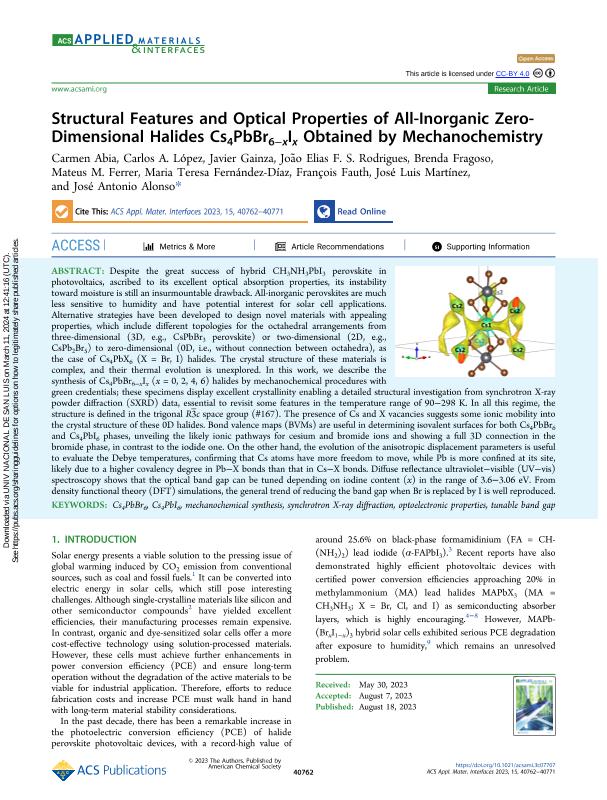Mostrar el registro sencillo del ítem
dc.contributor.author
Abia, Carmen
dc.contributor.author
Lopez, Carlos Alberto

dc.contributor.author
Gainza, Javier
dc.contributor.author
Rodrigues, João Elias F. S.
dc.contributor.author
Fragoso, Brenda
dc.contributor.author
Ferrer, Mateus M.
dc.contributor.author
Fernández Díaz, María Teresa
dc.contributor.author
Fauth, Francois
dc.contributor.author
Martínez, José Luis
dc.contributor.author
Alonso, José Antonio

dc.date.available
2024-04-09T10:17:14Z
dc.date.issued
2023-08
dc.identifier.citation
Abia, Carmen; Lopez, Carlos Alberto; Gainza, Javier; Rodrigues, João Elias F. S.; Fragoso, Brenda; et al.; Structural Features and Optical Properties of All-Inorganic Zero-Dimensional Halides Cs4PbBr6-xIx Obtained by Mechanochemistry; American Chemical Society; ACS Applied Materials and Interfaces; 15; 34; 8-2023; 40762-40771
dc.identifier.issn
1944-8252
dc.identifier.uri
http://hdl.handle.net/11336/232439
dc.description.abstract
Despite the great success of hybrid CH3NH3PbI3 perovskite in photovoltaics, ascribed to its excellent optical absorption properties, its instability toward moisture is still an insurmountable drawback. All-inorganic perovskites are much less sensitive to humidity and have potential interest for solar cell applications. Alternative strategies have been developed to design novel materials with appealing properties, which include different topologies for the octahedral arrangements from three-dimensional (3D, e.g., CsPbBr3 perovskite) or two-dimensional (2D, e.g., CsPb2Br5) to zero-dimensional (0D, i.e., without connection between octahedra), as the case of Cs4PbX6 (X = Br, I) halides. The crystal structure of these materials is complex, and their thermal evolution is unexplored. In this work, we describe the synthesis of Cs4PbBr6–xIx (x = 0, 2, 4, 6) halides by mechanochemical procedures with green credentials; these specimens display excellent crystallinity enabling a detailed structural investigation from synchrotron X-ray powder diffraction (SXRD) data, essential to revisit some features in the temperature range of 90–298 K. In all this regime, the structure is defined in the trigonal R3̅c space group (#167). The presence of Cs and X vacancies suggests some ionic mobility into the crystal structure of these 0D halides. Bond valence maps (BVMs) are useful in determining isovalent surfaces for both Cs4PbBr6 and Cs4PbI6 phases, unveiling the likely ionic pathways for cesium and bromide ions and showing a full 3D connection in the bromide phase, in contrast to the iodide one. On the other hand, the evolution of the anisotropic displacement parameters is useful to evaluate the Debye temperatures, confirming that Cs atoms have more freedom to move, while Pb is more confined at its site, likely due to a higher covalency degree in Pb–X bonds than that in Cs–X bonds. Diffuse reflectance ultraviolet–visible (UV–vis) spectroscopy shows that the optical band gap can be tuned depending on iodine content (x) in the range of 3.6–3.06 eV. From density functional theory (DFT) simulations, the general trend of reducing the band gap when Br is replaced by I is well reproduced.
dc.format
application/pdf
dc.language.iso
eng
dc.publisher
American Chemical Society

dc.rights
info:eu-repo/semantics/openAccess
dc.rights.uri
https://creativecommons.org/licenses/by/2.5/ar/
dc.subject
Zero Dimensional
dc.subject.classification
Química Inorgánica y Nuclear

dc.subject.classification
Ciencias Químicas

dc.subject.classification
CIENCIAS NATURALES Y EXACTAS

dc.title
Structural Features and Optical Properties of All-Inorganic Zero-Dimensional Halides Cs4PbBr6-xIx Obtained by Mechanochemistry
dc.type
info:eu-repo/semantics/article
dc.type
info:ar-repo/semantics/artículo
dc.type
info:eu-repo/semantics/publishedVersion
dc.date.updated
2024-03-25T12:22:25Z
dc.journal.volume
15
dc.journal.number
34
dc.journal.pagination
40762-40771
dc.journal.pais
Estados Unidos

dc.description.fil
Fil: Abia, Carmen. Instituto de Ciencia de Materiales de Madrid; España
dc.description.fil
Fil: Lopez, Carlos Alberto. Consejo Nacional de Investigaciones Científicas y Técnicas. Centro Científico Tecnológico Conicet - San Luis. Instituto de Investigaciones en Tecnología Química. Universidad Nacional de San Luis. Facultad de Química, Bioquímica y Farmacia. Instituto de Investigaciones en Tecnología Química; Argentina
dc.description.fil
Fil: Gainza, Javier. Instituto de Ciencia de Materiales de Madrid; España
dc.description.fil
Fil: Rodrigues, João Elias F. S.. European Synchrotron Radiation Facility; Francia
dc.description.fil
Fil: Fragoso, Brenda. Universidade Federal de Pelotas; Brasil
dc.description.fil
Fil: Ferrer, Mateus M.. Universidade Federal de Pelotas; Brasil
dc.description.fil
Fil: Fernández Díaz, María Teresa. Institut Laue Langevin; Francia
dc.description.fil
Fil: Fauth, Francois. No especifíca;
dc.description.fil
Fil: Martínez, José Luis. Instituto de Ciencia de Materiales de Madrid; España
dc.description.fil
Fil: Alonso, José Antonio. Instituto de Ciencia de Materiales de Madrid; España
dc.journal.title
ACS Applied Materials and Interfaces
dc.relation.alternativeid
info:eu-repo/semantics/altIdentifier/doi/http://dx.doi.org/10.1021/acsami.3c07707
Archivos asociados
